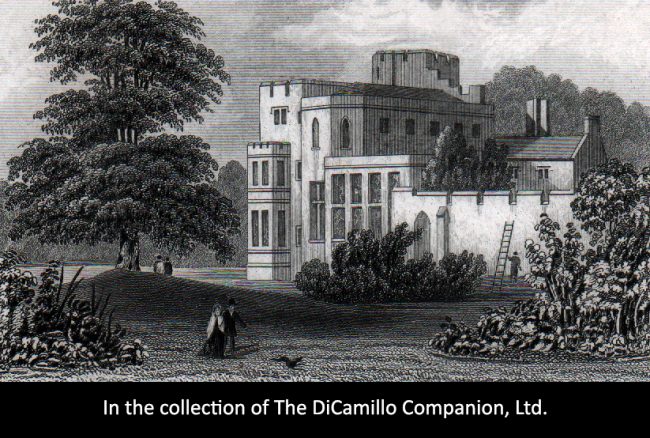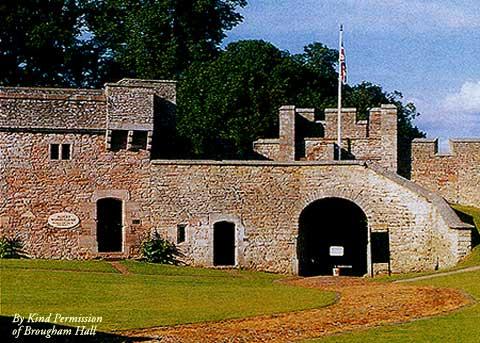
The House from a circa 1847 engraving from "Dugdale's England and Wales Delineated"

The House from an early 20th century postcard

House & Family History: Brougham Hall is situated in the center of Cumbria, within the Lake District. Brougham is a small parish on the ancient and modern crossroads of the county. In this parish are to be found, nestling around the Hall, three pre-historic henges, one long barrow (burial mound), two major Roman roads, a Roman fort, a Norman castle, one medieval hospital, two Cromwellian chapels (50% of the entire ecclesiastical output of England's brief republic) and the last battlefield on English soil: Clifton Moor December 18-19, 1745. Brougham dates to Saxon times. It was allegedly the home of Ivanhoe, immortalized by Sir Walter Scott. Written record commences in 1176. Although Roman ashlar is used in its foundations, the oldest complete building is 1480. The Chapel dates from 1649. All the medieval buildings were consolidated and unified by L.N. Cottingham between 1829 and 1840, using Smirke's rejected scheme for Windsor Castle. Brougham became known as the "Windsor of the North" and played host to many monarchs, particularly King Edward VII and King George V. The Hall's most important occupant was Lord Chancellor Brougham, who among other things, introduced the second most important piece of legislation in the English speaking world, after the Magna Carta - the Reform Bill of 1832. In the 1930s, the Hall was sold for demolition, after the 4th Lord Brougham had twice broken the bank at Monte Carlo, which eventually got its own back by breaking him. Churchill chose Brougham as a site for the development of one of the Allies five most top-secret weapons of World War II - the CDL Tank. After the War, the House became a prisoner of war camp and then lapsed into obscurity, until rescued by a trust intent upon its total restoration. It's important that any restored building has a viable and worthy late 20th century use. In this case, thus far, Brougham has two museums, its chapel and 13 craft units. It's open to the public from sunrise to sunset, every day except Christmas. (This information kindly provided by Brougham Hall).
Chapel & Church: The 1649 Chapel is extant.
Architect: Lewis Nockalls Cottingham
Date: Probably 1820sJohn Bernard (J.B.) Burke, published under the title of A Visitation of the Seats and Arms of the Noblemen and Gentlemen of Great Britain and Ireland, among other titles: Vol. I, p. 159, 1852.
Title: Biographical Dictionary of British Architects, 1600-1840, A - SOFTBACK
Author: Colvin, Howard
Year Published: 1995
Reference: pg. 271
Publisher: New Haven: Yale University Press
ISBN: 0300072074
Book Type: Softback
House Listed: Grade II*
Park Listed: Not Listed
Past Seat / Home of: Henry Brougham, 1st Baron Brougham and Vaux, 19th century.
Current Ownership Type: Charity / Nonprofit
Primary Current Ownership Use: Mixed Use
Ownership Details: Today a museum and craft center
House Open to Public: Yes
Phone: 01768-868-184
Fax: 01768-862-306
Website: http://www.broughamhall.co.uk
Historic Houses Member: No